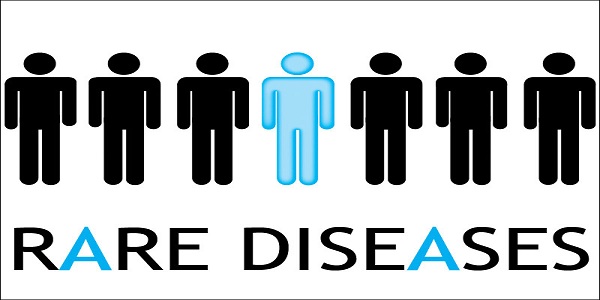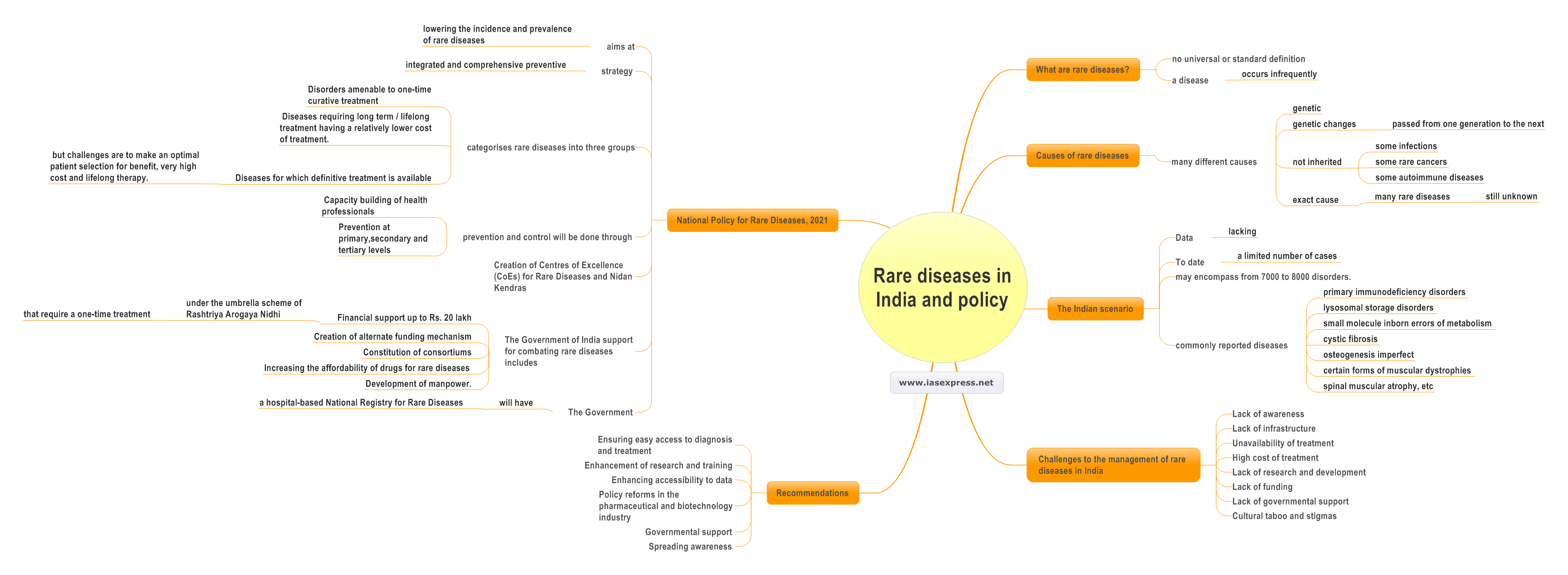Rare Diseases in India and Policy

From Current Affairs Notes for UPSC » Editorials & In-depths » This topic
IAS EXPRESS Vs UPSC Prelims 2024: 85+ questions reflected
The Government of India has recently notified the National Health Policy for Rare Diseases allocating Rs 4 crore to the All India Institute of Medical Sciences (AIIMS) while approving an estimated Rs 25 crore for the year 2021-22 exclusively dedicated to rare diseases. Rare diseases cumulatively affect around 350 million people worldwide of which 70 million people are from India. There has always been concern regarding India’s policy towards rare diseases and its lack of commitment towards finding a solution to this problem which can be seen through the meagre budgetary allocations for the health sector, especially for rare diseases. The absence of a public policy for the research and development of Orphan drugs adds to the problem. The new policy may come as a relief to those who need it yet India has a long way to go concerning its efforts and policies towards dealing with this issue.
What are rare diseases?
There is no universal or standard definition of rare disease. A disease that occurs infrequently is generally considered a rare disease. It has been defined by different countries in terms of prevalence –either in absolute terms or in terms of prevalence per 10,000 population. A country defines a rare disease most appropriate in the context of its own population, the health care system and resources.
Causes of rare diseases
- There are many different causes of rare diseases.
- The majority are thought to be genetic, directly caused by changes in genes or chromosomes.
- In some cases, genetic changes that cause disease are passed from one generation to the next. In other cases, they occur randomly in a person who is the first in a family to be diagnosed.
- Many rare diseases, including infections, some rare cancers, and some autoimmune diseases, are not inherited.
- While researchers are learning more each year, the exact cause of many rare diseases is still unknown.
The Indian scenario
- Data regarding the number of cases of rare diseases in India is lacking. The cases identified so far have been diagnosed at tertiary hospitals.
- To date, only a limited number of cases have been recorded in India from tertiary care hospitals that are globally considered as rare diseases though the ambit may encompass from 7000 to 8000 disorders.
- The commonly reported diseases include primary immunodeficiency disorders, lysosomal storage disorders (Gaucher’s disease, Mucopolysaccharidoses, Pompe disease, Fabry disease etc.) small molecule inborn errors of metabolism (Maple Syrup urine disease, organic acidemias.), cystic fibrosis, osteogenesis imperfect, certain forms of muscular dystrophies and spinal muscular atrophy, etc.
Challenges to the management of rare diseases in India
- Lack of awareness – There is a significant amount of lack of awareness not only among people but also among physicians. The health care training and education system in India are more focused on training physicians and health care personnel to treat common and known diseases. This has led to a lack of trained physicians and health care personnel to care for patients with rare diseases.
- Lack of infrastructure – There is a lack of facilities and adequate training to diagnose such diseases on time. Additionally, there is a lack of adequate statistics and data on incidence as well as the prevalence of rare diseases in India. This works as a hurdle for policymakers, physicians, scientists, drug or device manufacturers, patients and the community at large.
- Unavailability of treatment – Given the absence of adequate training and health infrastructure and medicines, it becomes difficult to avail treatment. Many a time, there is no treatment available in India and patients have to consult foreign healthcare professionals or avail treatment in foreign countries.
- High cost of treatment – A large number of patients who are affected by rare diseases cannot afford the high cost of treatment for these diseases. Most of the drugs prescribed are not curative rather they manage the symptoms and need to be administered regularly. Thus, the expensive cost of drugs makes it difficult to manage.
- Lack of research and development – It is very difficult to research such diseases as the number of patients is very small and leads to inadequate clinical experience. Lack of research also leads to inadequate knowledge regarding such diseases.
- Lack of funding – Those who carry out or are willing to research this field lack funding. Funding is important to research the long term.
- Lack of governmental support – There is a lack of governmental support for research and development in the field of rare diseases. Furthermore, there seems to be an absence of an official policy on rare diseases in India.
- Cultural taboo and stigmas – Social stigmas for disabled individuals and patients with rare diseases continue to be a societal challenge in the management of rare diseases in India.
Recommendations
- Ensuring easy access to diagnosis and treatment – Patients with rare diseases and their families need quick and easy access to information about affordable diagnosis and treatment options. A single portal for such information would serve the purpose and is urgently needed.
- Enhancement of research and training – Indian health professionals need access to more clinical training, research and education on rare diseases. They also need access to state-of-the-art diagnostic tests, information on clinical trials and currently available drugs for rare diseases in India.
- Enhancing accessibility to data – Scientists need access to rare disease patient registries and biorepositories to advance science and understanding of these diseases to translate research findings into diagnostic tests and therapeutics.
- Policy reforms in the pharmaceutical and biotechnology industry – India needs an Orphan Drug Act type of legislation because the absence of such legislation is hampering the indigenous development of drugs for rare diseases. This may bring down the cost of medicines for such diseases.
- Governmental support – The government should play an active role in addressing the enormous health care challenges posed by rare diseases through various mechanisms such as public funding for research in orphan diseases, creating business-friendly policies for pharmaceutical and biotech companies and developing a balanced regulatory framework that catalyses innovation and protects the safety of patients.
- Spreading awareness – Awareness can play an important role in the diagnosis of diseases and the eradication of cultural and social stigmas against such patients. This can be done through mass media, newspapers, television, social media, pamphlets and posters.
National Policy for Rare Diseases, 2021
- The policy aims at lowering the incidence and prevalence of rare diseases.
- It will do so through an integrated and comprehensive preventive strategy which will encompass:-
- Awareness generation.
- Premarital, post-marital, pre-conception and post-conception screening and counselling programmes to prevent births of children with rare diseases.
- Enable access to affordable health care to patients of rare diseases which are amenable to one-time treatment or relatively low-cost therapy.
- The policy categorises rare diseases into three groups –
- Disorders amenable to one-time curative treatment.
- Diseases requiring long term / lifelong treatment having a relatively lower cost of treatment.
- Diseases for which definitive treatment is available but challenges are to make an optimal patient selection for benefit, very high cost and lifelong therapy.
- The prevention and control of rare diseases will be done through:-
- Capacity building of health professionals
- Prevention at primary (prevention of birth of an affected child), secondary (prenatal screening, prenatal diagnosis by invasive testing, newborn screening, early postnatal diagnosis and treatment) and tertiary levels (optimal screening and diagnosis strategy).
- Creation of Centres of Excellence (CoEs) for Rare Diseases and Nidan Kendras.
- CoEs will have the responsibilities of:-
- Education and training at all levels.
- Prevention by prenatal screening and diagnosis.
- Research in the area of low-cost diagnostics and therapeutics.
- Treatment of rare diseases.
- The Nidan Kendras will be performing screening, genetic testing and counselling for rare diseases.
- The Government of India support for combating rare diseases includes:-
- Financial support up to Rs. 20 lakh under the umbrella scheme of Rashtriya Arogaya Nidhi shall be provided by the Central Government for treatment, of those rare diseases that require a one-time treatment (diseases listed under Group 1).
- Creation of alternate funding mechanism through setting up a digital platform for voluntary individual and corporate donors to contribute to the treatment cost of patients of rare diseases.
- Constitution of consortiums which will include Consortium of Centres of Excellence and National Consortium for Research and Development on therapeutics for Rare Diseases.
- Increasing the affordability of drugs related to rare diseases through research and development on rare diseases.
- Development of manpower.
- The Government will have a hospital-based National Registry for Rare Diseases at ICMR to create a database of various rare diseases.
Conclusion
Rare diseases are a challenge not only to India but to the entire world. With emerging technologies, it has become less difficult to address this issue in the developed world. India can learn from such nations and can utilise their experiences in finding a solution to the issue. Although the government has taken initial steps, it has to take steps further by encouraging research, innovation and collaboration between all the stakeholders. Prevention needs to be the focus and freedom from such diseases the aim.
Practise question
- Comment on India’s policy in dealing with rare diseases.
If you like this post, please share your feedback in the comments section below so that we will upload more posts like this.



INDIA
I dealt with four IAS, four PCS, justices, they plotted my murder to steal my property in UP. My murder plan failed, I got injured, suffered a massive heart attack, was hospitalised for ten days in Allahabad, returned to Canada, had triple bypass open-heart surgery, prior to the murder attack in India, and I never had any health problems. India is a criminal Kleptocracy. India to set up similar to the Nuremberg trial to prosecute homegrown criminals similar to those who plotted my murder.
Victoria, British Columbia, Canada